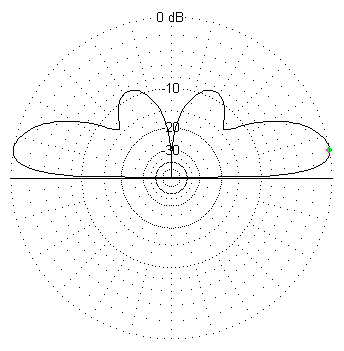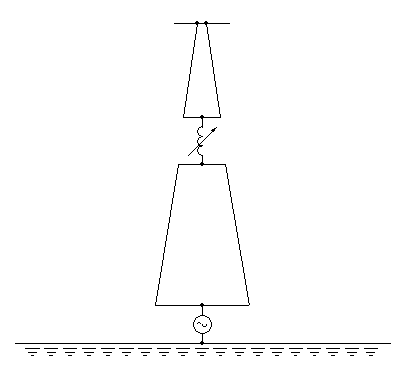
In order to get a rough idea of the performance of such antenna, it has been simulated and the gain, the radiation pattern, the antenna impedance and the current distribution has been calculated. Precise data about the structure are not available and the dimensions have been estimated via observations on site. No antenna performance data is available and therefore the result of the simulation cannot be checked against the reality and may be considerably wrong, but the figures look plausible and are reported and commented below.
The main antenna of the Beromünster transmitter is a self supporting tower 215 m high. Its base is insulated from ground and connected to the feeder via a matching network. At 150 m above ground a variable coil is inserted in series with the mast and adjusted for the desired radiation pattern. On top of the antenna there is a small capacitive hat. Transmission frequency is 531 kHz, one wavelength is 565 m and a quarter wavelength is 141 m.

Ground conductivity has a very big influence on the gain (the higher the conductivity the higher the gain), the elevation angle (the higher the conductivity the lower the angle) and the impedance. Unfortunately no information about ground conductivity is available. Since this antenna has buried radials to increase ground conductivity, a value of 10 mS/m has been arbitrary chosen.
No information is available about the variable coil in the middle of the tower, so it has been experimentally adjusted until a good compromise between gain, elevation angle and side lobes has been achieved. It seems that with an inductor of 65 μH the results are pretty good.
The simulation shows a gain of 1.9 dBd (including losses), an elevation angle of 12° and a half power beam-width of 26°. A very low radiation angle is important for long distance broadcast. The radiation pattern also shows no side lobes at high angles, meaning reduced fading in the reception, which is a very important feature of a broadcast antenna.
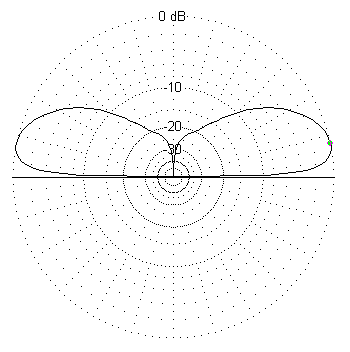
The current distribution on the mast is similar to a λ/2 dipole, but is shifted upwards by the inductor and shows a minimum slightly above the base. This particular current distribution is usual in broadcast tower since it makes a very good radiation pattern. The maximum current is 145 A at 146 m above ground (right at the lower end of the coil). There is a minimum in the current of 18 A at about 45 m above ground.
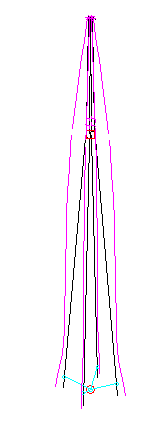
The feed impedance is (43 – j250) Ω, meaning that for a power of 500 kW, the feed current is about 110 A and the feed voltage is 28 kV. To have a comparison, 500 kW on a 50Ω resistive load require a voltage of 5 kV and a current of 100 A.
The coil at 150 m above the ground can make the antenna electrically longer and produces a current minimum near the base. The position of this minimum can be adjusted by varying the inductance of this coil. This has a significant effect on the radiation pattern and on the feed impedance.
The following radiation pattern is what happens is the coil is reduced from 65 μH to 45 μH. The gain drops to 1.7 dBd, the elevation angle rises to 13° and the half power beam-width increases to 29°. Since the current minimum is very close to the ground, no extra side lobes are visible. The feed impedance is now (220 – j350) Ω.
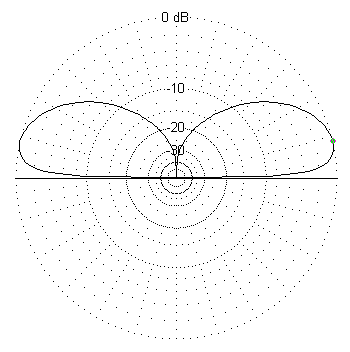
If, on the other hand, the inductance is increased from 65 μH to 75 μH, the radiation pattern can be observed in the following plot. The gain rises to 2.2 dBd, the elevation angle drops to 10° and the half power beam-width shrinks to 21°. Since the current minimum is now further above ground, side lobes this high angles are now present. These side lobes are responsible for interference (fading) in the reception and are therefore always minimized. The feed impedance is now (5.6 – j170) Ω.
